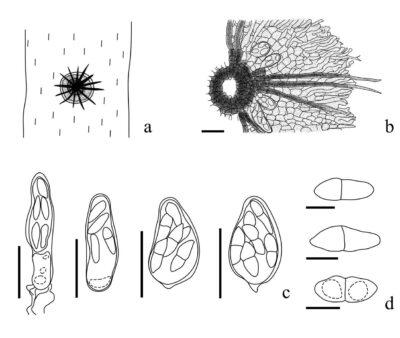Fungalpedia – Note 382, Chaetothyriothecium
Chaetothyriothecium Hongsanan & K.D. Hyde
Citation when using this data: Tibpromma et al. 2024 (in prep.) – Fungalpedia, Ascomycota.
Index Fungorum, Facesoffungi; MycoBank, GenBank, Fig. 1
Classification: Microthyriaceae, Microthyriales, Incertae sedis, Dothideomycetes, Pezizomycotina, Ascomycota, Fungi
Based on phylogenies of LSU analyses and morphological studies, Chaetothyriothecium, a “Microthyriaceae”-like fungus collected in central Thailand was established by Hongsanan et al. (2014) to accommodate the type species Chaetothyriothecium elegans. Chaetothyriothecium is characterized by superficial, globose, dark brown to black ascomata, ostioles surrounded by long setae, bitunicate asci, 4−8-spored, and bi-celled hyaline ascospores with oblong to ellipsoid (Hongsanan et al. 2014). Chaetothyriothecium can be recognized by the presence of long, dark brown setae at the center surrounding the ostiole (Hongsanan et al. 2014). No other species have been introduced to this genus, which remains monotypic.
Type species: Chaetothyriothecium elegans Hongsanan & K.D. Hyde
Other accepted species: This genus is monotypic.
Figure 1 – Chaetothyriothecium elegans. a Thyriothecia on the surface of the host. b Ostiole surrounded by long setae, upper wall comprising central cells in a radial to parallel arrangement and meandering hyphae at the rim, and asci forming beneath upper thyriothecia walls. c Asci. d Ascospore. Scale bars: b = 10 µm. c = 20 µm, d = 5 µm. Redrawn from Hongsanan et al. (2014).
Reference
Entry by
Du TY, Center for Yunnan Plateau Biological Resources Protection and Utilization, College of Biological Resource and Food Engineering, Qujing Normal University, Qujing, Yunnan 655011, China; Center of Excellence in Fungal Research, Mae Fah Luang University, Chiang Rai 57100, Thailand; School of Science, Mae Fah Luang University, Chiang Rai 57100, Thailand.
(Edited by Saowaluck Tibpromma, Samaneh Chaharmiri-Dokhaharani, & Achala R. Rathnayaka)
Published online 25 November 2024
